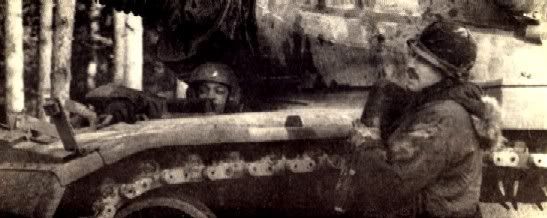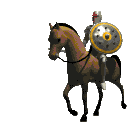Mood:
Now Playing: Wolf Moon by TYPE O NEGATIVE
 Warriors Citation 1st Armored Division: America’s Tank Warriors NORTH AFRICA As part of Operation Torch, the Allied invasion of French Northwest Africa, November 8, 1942. In doing so, Old Ironsides became the first American Armored Division to see combat. Although encountering unexpectedly heavy Vichy-French opposition, the Allied invasion warrior force suppressed all resistance in the beachhead within three days. The Division then advanced toward Tunisia where it clashed with Axis forces and learned many hard lessons in armored warfare. Harsh conditions and primitive roads spoiled an early opportunity to capture Tunisia and cut off Rommel's supply lines. January 1943 found the Division under control of the II Corps. Old Ironsides received the mission of defending central Tunisia against an Axis counterattack. A month later, the 1st Armored Division collided with a superior German armored force at Kasserine Pass. Sustaining heavy personnel and equipment losses, Old Ironsides withdrew, battered but wiser. Outrunning his supply lines and facing stiffening Allied resistance, Rommel's advance ground to a halt. Regardless, three more months of fierce fighting followed before the Allied warriors could finally claim victory in North Africa. ITALY The fall of Sicily in the summer of 1943 cleared the way for an Allied Invasion of the Italian mainland. As part of General Mark Clark's Fifth Army, 1st Armored Division warriors crushed enemy resistance in an assault landing at Salerno on September 9, and led the drive to Naples. The city fell on October 1, and the Allies pressed onto the Volturno River. In November, the 1st Armored Division attacked the infamous Winter Line. Although breaching the line, the Allied advance came to a halt in the mountainous country near Cassino. To break the stalemate, the Allies made an amphibious assault well behind enemy lines at Anzio on January 23, 1944. Beating back repeated German counterattacks, 1st Armored Division warriors led the Allied breakout from the beachead on May 23, and spearheaded the drive to Rome, liberating the city on June 4. The 1st Armored Division continued its pursuit of the enemy to the North Apennies where the Germans made their last stand. Rugged mountains and winter weather now stood between the Allies and the open land of the Po Valley. 1st Armored Division warriors broke into the valley in April 1945 and on May 2, 1945, German forces in Italy surrendered. VIETNAM Although, the 1st Armored Division did not participate as a Division in the Vietnam War, two units, Company A, 501st Aviation and 1st Squadron, 1st Calvary served with distinction. Both earned Presidential Unit Citations, and 1-1 Cavalry received two Valorous Unit Awards and three Vietnamese Crosses of Gallantry. Neither unit was officially detached from the 1st Armored Division and veterans of both units may wear the Old Ironsides as a combat patch. In addition, in 1967 the 198th Infantry Brigade was formed from three of the Division's Infantry Battalions and deployed from Fort Hood to Vietnam. After the war, two of the three battalions, 1-6 Infantry and 1-52 Infantry, returned to the 1st Armored Division. 1968 was a crisis-filled year of domestic unrest. After the assassination of Martin Luther King, several inner cities exploded into violence. 3rd Brigade warriors deployed to Chicago to assist in restoring order. WEST GERMANY
Warriors Citation 1st Armored Division: America’s Tank Warriors NORTH AFRICA As part of Operation Torch, the Allied invasion of French Northwest Africa, November 8, 1942. In doing so, Old Ironsides became the first American Armored Division to see combat. Although encountering unexpectedly heavy Vichy-French opposition, the Allied invasion warrior force suppressed all resistance in the beachhead within three days. The Division then advanced toward Tunisia where it clashed with Axis forces and learned many hard lessons in armored warfare. Harsh conditions and primitive roads spoiled an early opportunity to capture Tunisia and cut off Rommel's supply lines. January 1943 found the Division under control of the II Corps. Old Ironsides received the mission of defending central Tunisia against an Axis counterattack. A month later, the 1st Armored Division collided with a superior German armored force at Kasserine Pass. Sustaining heavy personnel and equipment losses, Old Ironsides withdrew, battered but wiser. Outrunning his supply lines and facing stiffening Allied resistance, Rommel's advance ground to a halt. Regardless, three more months of fierce fighting followed before the Allied warriors could finally claim victory in North Africa. ITALY The fall of Sicily in the summer of 1943 cleared the way for an Allied Invasion of the Italian mainland. As part of General Mark Clark's Fifth Army, 1st Armored Division warriors crushed enemy resistance in an assault landing at Salerno on September 9, and led the drive to Naples. The city fell on October 1, and the Allies pressed onto the Volturno River. In November, the 1st Armored Division attacked the infamous Winter Line. Although breaching the line, the Allied advance came to a halt in the mountainous country near Cassino. To break the stalemate, the Allies made an amphibious assault well behind enemy lines at Anzio on January 23, 1944. Beating back repeated German counterattacks, 1st Armored Division warriors led the Allied breakout from the beachead on May 23, and spearheaded the drive to Rome, liberating the city on June 4. The 1st Armored Division continued its pursuit of the enemy to the North Apennies where the Germans made their last stand. Rugged mountains and winter weather now stood between the Allies and the open land of the Po Valley. 1st Armored Division warriors broke into the valley in April 1945 and on May 2, 1945, German forces in Italy surrendered. VIETNAM Although, the 1st Armored Division did not participate as a Division in the Vietnam War, two units, Company A, 501st Aviation and 1st Squadron, 1st Calvary served with distinction. Both earned Presidential Unit Citations, and 1-1 Cavalry received two Valorous Unit Awards and three Vietnamese Crosses of Gallantry. Neither unit was officially detached from the 1st Armored Division and veterans of both units may wear the Old Ironsides as a combat patch. In addition, in 1967 the 198th Infantry Brigade was formed from three of the Division's Infantry Battalions and deployed from Fort Hood to Vietnam. After the war, two of the three battalions, 1-6 Infantry and 1-52 Infantry, returned to the 1st Armored Division. 1968 was a crisis-filled year of domestic unrest. After the assassination of Martin Luther King, several inner cities exploded into violence. 3rd Brigade warriors deployed to Chicago to assist in restoring order. WEST GERMANY  DESERT SHIELD/DESERT STORM Old Ironsides warriors marched into its second half century celebrating victory in the Cold War - a triumph symbolized by the fall of the Berlin Wall, the unification of Germany, and the crumbling of East European, communist regimes. Almost immediately 1st Armored Division warriors were called upon to meet a new challenge. In November 1990 it was alerted for deployment to the Middle East in response to the Iraqi invasion of Kuwait. In less than two months the Division moved 17,400 warriors and 7,050 pieces of equipment by rail, sea, and air to Saudi Arabia for Operation Desert Shield/Storm. The Division's own 1st Brigade stayed in Germany and was replaced by 3d Brigade, 3d Infantry Division. On February 24, 1991, the 1st Armored Division crossed into Iraq leading VII Corp's main flanking attack - its mission to destroy the elite, Iraqi Republican Guards Divisions. In its 89-hour blitz across the desert Old Ironsides traveled 250 kilometers; destroyed 768 tanks, APCs and artillery pieces; and captured 1,064 prisoners of war. Four 1st Armored Division warriors made the ultimate sacrifice in this historic effort. OPERATION IRAQI FREEDOM The Division warriors again answered the Nation’s call to duty March 4, 2003 when it received orders to deploy to the U.S. Central Command area of responsibility in support of the global war on terrorism . “Old Ironsides” began moving out April 15 in Support of Operation Iraqi Freedom. The division and warrior task force marked some major “firsts” during the 15-month long mission. For warriors of the 1st Armored Division, this was longest deployment of any division in Iraq. Task Force 1st Armored Division was the largest division-based task force in U.S. Army history. Units serving with the Task Force included brigade-sized elements of the 82nd Airborne and 3rd Infantry and 1st Cavalry Divisions, the 2nd Armored Cavalry Regiment, the 124th Infantry Battalion, the 18th and 89th Military Police Brigades and 168th MP Battalion. Engineer units serving with the task force included the 153rd, 203rd, 389th, 439th, 535th, 842nd and 1457th Engineer Battalions, the 493rd Engineer Group, and the 249th and 671st Engineer Companies. Also serving the task force were the 55th Personnel Service Battalion, the 8th Finance Battalion, the 350th and 354th Civil Affairs Battalions, the 315th and 345th PSYOP Battalions and the 16th Corps Support Group. At its height, more than 39,000 Soldiers were part of the task force. The warrior task force secured some of Baghdad’s roughest neighborhoods and brought stability to the city and its surrounding countryside. The Task Force’s accomplishments included planning and executing Operations Iron Hammer, Iron Justice, Iron Grip, Longstreet, Iron Bullet, Iron Promise and Iron Sabre. During these task force operations, warriorrs captured more than 700 criminals and former regime insurgents. They also confiscated thousands of rockets, mortars, tank rounds, rocket-propelled grenades and small arms. In addition to combat, task force Warriors protected and improved the quality of life for over 5 million Iraqi residents in the city of Baghdad. The task force trained Iraqi police and national guardsmen, renovated schools, established neighborhood councils and spent over $60 million on these and other projects. After turning the city over to the 1st Cavalry Division April 15, the warrior task force headed south to pacify the cities of Najaf, Diwaniyah, Al Kut and Karbala. Those mission successes and achievements did not come without cost. During Operation Iraqi Freedom, 133 Iron Warriors lost their lives while serving in Iraq and 1,111 were wounded in combat. From: US Military Records 2007-08-08©bravehorseswarriors™09
DESERT SHIELD/DESERT STORM Old Ironsides warriors marched into its second half century celebrating victory in the Cold War - a triumph symbolized by the fall of the Berlin Wall, the unification of Germany, and the crumbling of East European, communist regimes. Almost immediately 1st Armored Division warriors were called upon to meet a new challenge. In November 1990 it was alerted for deployment to the Middle East in response to the Iraqi invasion of Kuwait. In less than two months the Division moved 17,400 warriors and 7,050 pieces of equipment by rail, sea, and air to Saudi Arabia for Operation Desert Shield/Storm. The Division's own 1st Brigade stayed in Germany and was replaced by 3d Brigade, 3d Infantry Division. On February 24, 1991, the 1st Armored Division crossed into Iraq leading VII Corp's main flanking attack - its mission to destroy the elite, Iraqi Republican Guards Divisions. In its 89-hour blitz across the desert Old Ironsides traveled 250 kilometers; destroyed 768 tanks, APCs and artillery pieces; and captured 1,064 prisoners of war. Four 1st Armored Division warriors made the ultimate sacrifice in this historic effort. OPERATION IRAQI FREEDOM The Division warriors again answered the Nation’s call to duty March 4, 2003 when it received orders to deploy to the U.S. Central Command area of responsibility in support of the global war on terrorism . “Old Ironsides” began moving out April 15 in Support of Operation Iraqi Freedom. The division and warrior task force marked some major “firsts” during the 15-month long mission. For warriors of the 1st Armored Division, this was longest deployment of any division in Iraq. Task Force 1st Armored Division was the largest division-based task force in U.S. Army history. Units serving with the Task Force included brigade-sized elements of the 82nd Airborne and 3rd Infantry and 1st Cavalry Divisions, the 2nd Armored Cavalry Regiment, the 124th Infantry Battalion, the 18th and 89th Military Police Brigades and 168th MP Battalion. Engineer units serving with the task force included the 153rd, 203rd, 389th, 439th, 535th, 842nd and 1457th Engineer Battalions, the 493rd Engineer Group, and the 249th and 671st Engineer Companies. Also serving the task force were the 55th Personnel Service Battalion, the 8th Finance Battalion, the 350th and 354th Civil Affairs Battalions, the 315th and 345th PSYOP Battalions and the 16th Corps Support Group. At its height, more than 39,000 Soldiers were part of the task force. The warrior task force secured some of Baghdad’s roughest neighborhoods and brought stability to the city and its surrounding countryside. The Task Force’s accomplishments included planning and executing Operations Iron Hammer, Iron Justice, Iron Grip, Longstreet, Iron Bullet, Iron Promise and Iron Sabre. During these task force operations, warriorrs captured more than 700 criminals and former regime insurgents. They also confiscated thousands of rockets, mortars, tank rounds, rocket-propelled grenades and small arms. In addition to combat, task force Warriors protected and improved the quality of life for over 5 million Iraqi residents in the city of Baghdad. The task force trained Iraqi police and national guardsmen, renovated schools, established neighborhood councils and spent over $60 million on these and other projects. After turning the city over to the 1st Cavalry Division April 15, the warrior task force headed south to pacify the cities of Najaf, Diwaniyah, Al Kut and Karbala. Those mission successes and achievements did not come without cost. During Operation Iraqi Freedom, 133 Iron Warriors lost their lives while serving in Iraq and 1,111 were wounded in combat. From: US Military Records 2007-08-08©bravehorseswarriors™09  Warriors, Places, & Events
Warriors, Places, & Events 
Posted by adjunctprofessor
at 4:10 AM EDT

